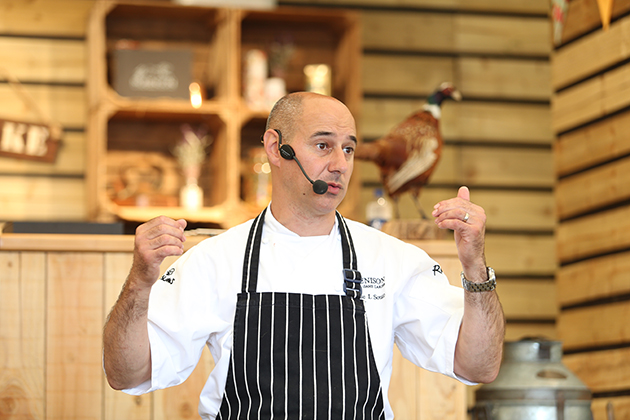Chef José Souto is keen on cooking with wild Alaska salmon, and will be doing so in The Field Kitchen theatre, at this year's Game Fair at Ragley Hall. But why does Alaska salmon get his vote?
The Game Fair celebrates 60 years at Ragley this July. And in The Field Kitchen Theatre, José Souto will be cooking with wild Alaska salmon. But why?
JOSE SOUTO, GAME CHEF
José Souto, a chef and senior chef lecturer in culinary arts, says:
“I am super careful about what I promote. When choosing food to cook and to use for teaching, sustainability and responsible food sourcing are vital and essential factors. Having visited Alaska, I know from personal experience that it is one of the world’s leading authorities on fish stock management. Wild seafood from this part of North America has both superior texture and exquisite flavour, making it amazing to cook with. That’s why I choose wild Alaska salmon.”
Chef José Souto has good reason to prefer cooking with wild Alaska salmon
ALASKA SOCKEYE SALMON
Wild sockeye salmon are born in Alaskan rivers and make their way to sea. There they spend three or four years in the sea before returning to their natural birth spot for spawning. Many millions of salmon are caught every year for human consumption. However Alaskan salmon fisheries manage fish stocks conservatively by setting escapement goals. These enable sufficient numbers to evade capture and make their way to the spawning grounds.
WILD ALASKA SALMON MANAGEMENT
Copper River salmon are counted using sonar. Other fisheries use flying surveys or visually count the fish by video or from stands as they migrate upstream. To prevent overfishing in some areas, anglers are allocated a specified time to fish – called an opener – which is determined by the number caught. This however is not a one-size-fits-all policy across Alaska’s fisheries. Systems of management vary throughout Alaska.
UK SALMON MANAGEMENT
The sustainability programme we have in the UK is very different. Quotas are set a long time after studies have been done, In Alaskan fisheries instant tactical decisions are made daily by a process called ‘in season management’, counting the individual salmon as they swim up the rivers.
FIRST FOR TASTE AND FLAVOUR
Wild salmon fishing in the UK is not sustainable. Therefore I will be cooking with wild Alaska sockeye salmon at The Game Fair this year. The sockeye salmon, similar to our wild salmon in the UK, is small with a really rich and deep red colour. The flesh has a muscular texture, yet still contains all the omega 3 oils found in oily fish. As it is a very lean meat, great care has to be taken over its cooking. Overcook it at your peril –a dry fish will ensue. Based purely and simply on taste and texture, wild Alaska sockeye salmon is the undoubted winner.
MEET ME AT THE GAME FAIR

Come and see Alaska wild salmon being cooked by José Souto at The Field Kitchen Theatre this year
I’m looking forward to talking through Alaska’s sustainability programme and sharing my wild Alaska salmon recipes at The Game Fair this year. I’ll be demonstrating how to prepare some starter dishes using wild Alaska sockeye salmon in The Field Kitchen Theatre.
A TASTE OF ALASKA AT THE FIELD KITCHEN THEATRE
- Ceviche, raw salmon with a lovely citrus dressing.
- How to hot smoke salmon and what you can do with it.
- Wild Alaska salmon tartare with capers and gherkins, very refreshing and perfect for hot weather.
Please come and join me at The Field Kitchen Theatre. I look forward to seeing you all there.
The Game Fair takes place at Ragley hall in Warwickshire from Friday 27 July to Sunday 29 July, 2018.






